Comparing B2C and B2B Consumer Decision-Making Processes - Report
VerifiedAdded on 2020/11/12
|11
|3828
|105
Report
AI Summary
This report provides a detailed analysis of the consumer decision-making processes in both Business-to-Consumer (B2C) and Business-to-Business (B2B) contexts. It begins by outlining the stages of the consumer decision-making process for a given product or service, referencing models like the Input, Process, and Output Model. The report emphasizes the importance of understanding these processes for marketers, highlighting how mapping the path to purchase can increase sales and brand value. It then compares the key differences between B2C and B2B decision-making, focusing on aspects such as need identification, product specifications, supplier evaluation, purchase decisions, and post-purchase behavior. Furthermore, the report evaluates how marketers influence different stages of the decision-making process in both B2C and B2B environments, considering the application of relevant marketing concepts and models like Consideration and Involvement. The report concludes with a critical evaluation of how marketers can effectively influence each stage of the decision-making process, providing valuable insights for marketing professionals.
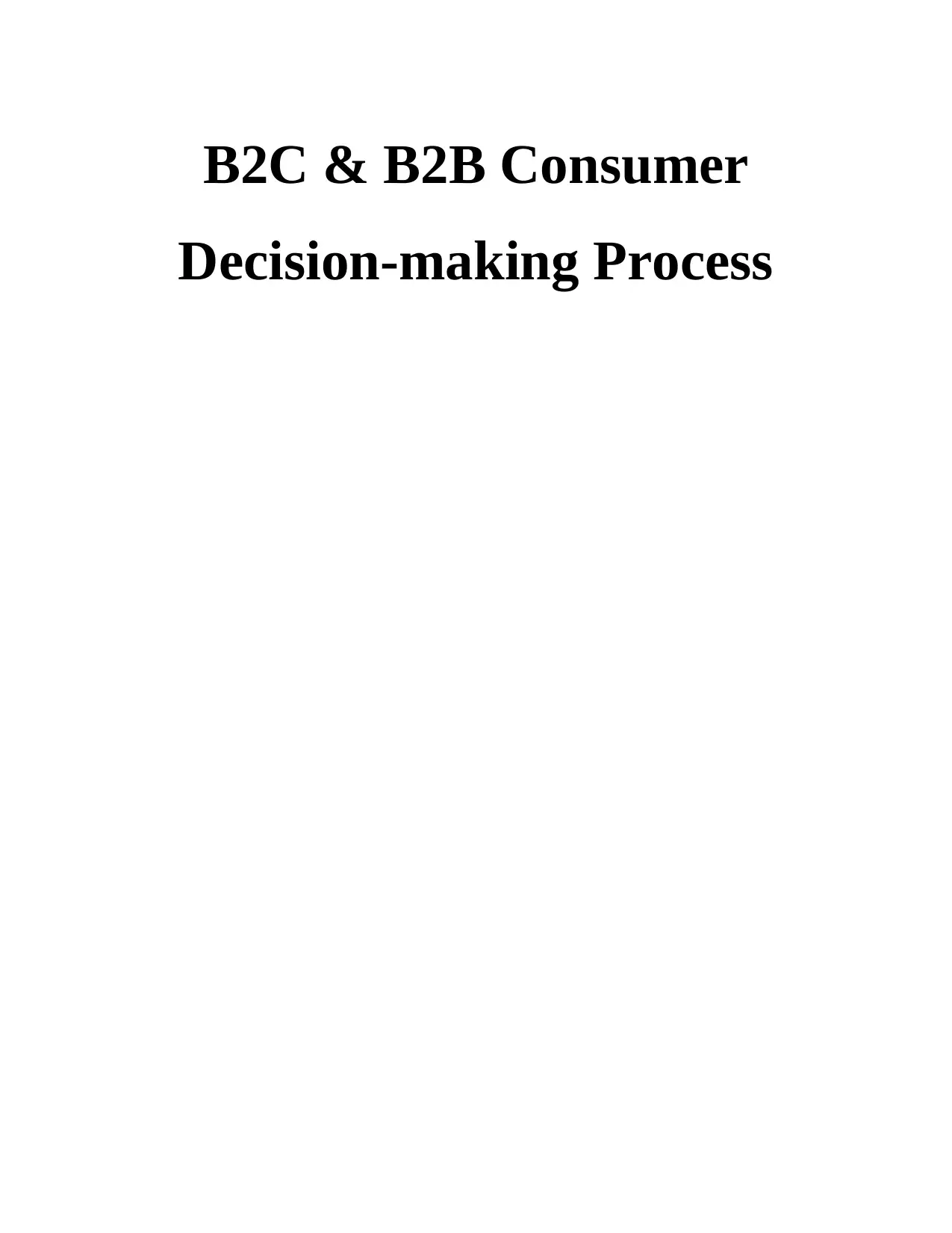
B2C & B2B Consumer
Decision-making Process
Decision-making Process
Paraphrase This Document
Need a fresh take? Get an instant paraphrase of this document with our AI Paraphraser
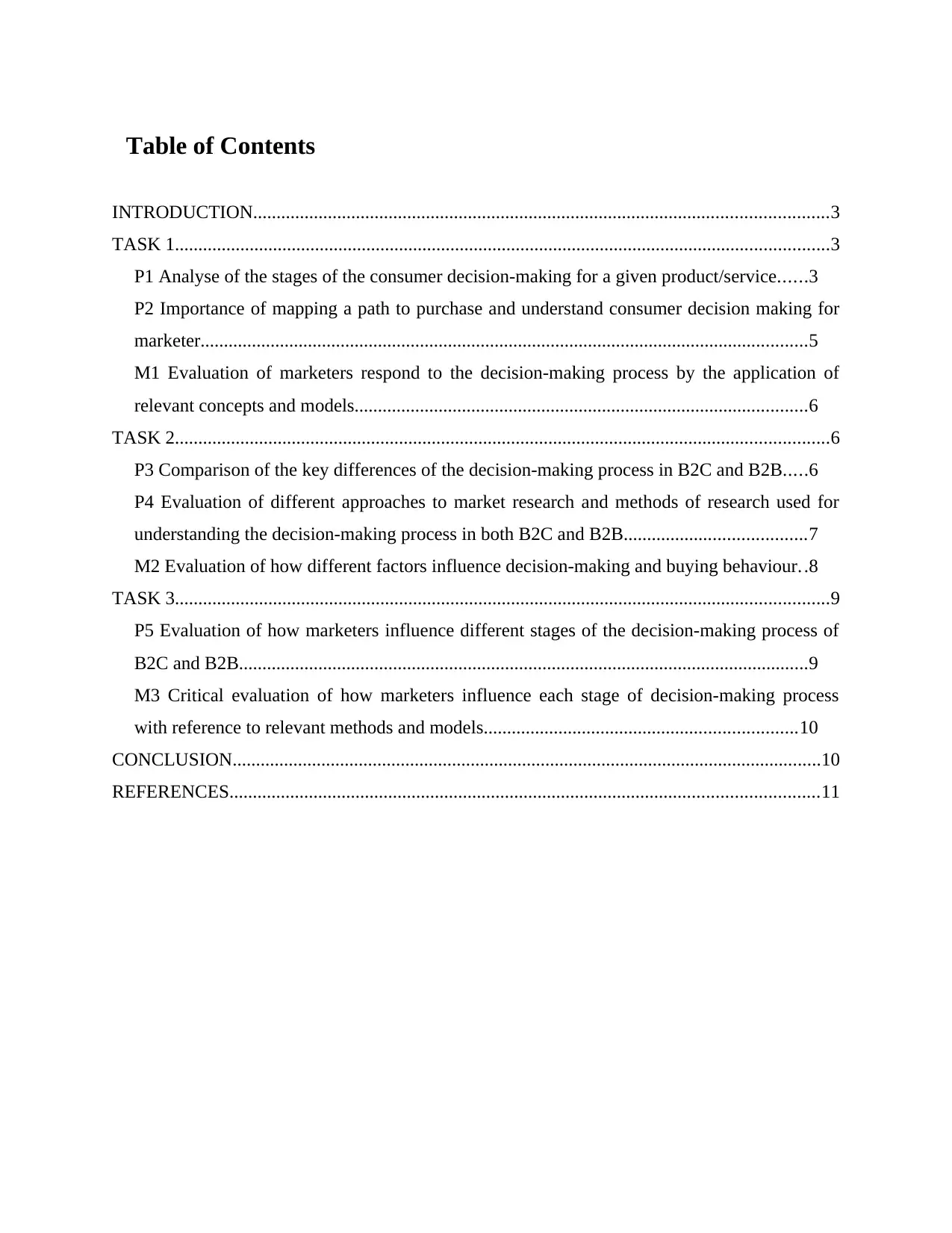
Table of Contents
INTRODUCTION...........................................................................................................................3
TASK 1............................................................................................................................................3
P1 Analyse of the stages of the consumer decision-making for a given product/service......3
P2 Importance of mapping a path to purchase and understand consumer decision making for
marketer..................................................................................................................................5
M1 Evaluation of marketers respond to the decision-making process by the application of
relevant concepts and models.................................................................................................6
TASK 2............................................................................................................................................6
P3 Comparison of the key differences of the decision-making process in B2C and B2B.....6
P4 Evaluation of different approaches to market research and methods of research used for
understanding the decision-making process in both B2C and B2B.......................................7
M2 Evaluation of how different factors influence decision-making and buying behaviour..8
TASK 3............................................................................................................................................9
P5 Evaluation of how marketers influence different stages of the decision-making process of
B2C and B2B..........................................................................................................................9
M3 Critical evaluation of how marketers influence each stage of decision-making process
with reference to relevant methods and models...................................................................10
CONCLUSION..............................................................................................................................10
REFERENCES..............................................................................................................................11
INTRODUCTION...........................................................................................................................3
TASK 1............................................................................................................................................3
P1 Analyse of the stages of the consumer decision-making for a given product/service......3
P2 Importance of mapping a path to purchase and understand consumer decision making for
marketer..................................................................................................................................5
M1 Evaluation of marketers respond to the decision-making process by the application of
relevant concepts and models.................................................................................................6
TASK 2............................................................................................................................................6
P3 Comparison of the key differences of the decision-making process in B2C and B2B.....6
P4 Evaluation of different approaches to market research and methods of research used for
understanding the decision-making process in both B2C and B2B.......................................7
M2 Evaluation of how different factors influence decision-making and buying behaviour..8
TASK 3............................................................................................................................................9
P5 Evaluation of how marketers influence different stages of the decision-making process of
B2C and B2B..........................................................................................................................9
M3 Critical evaluation of how marketers influence each stage of decision-making process
with reference to relevant methods and models...................................................................10
CONCLUSION..............................................................................................................................10
REFERENCES..............................................................................................................................11
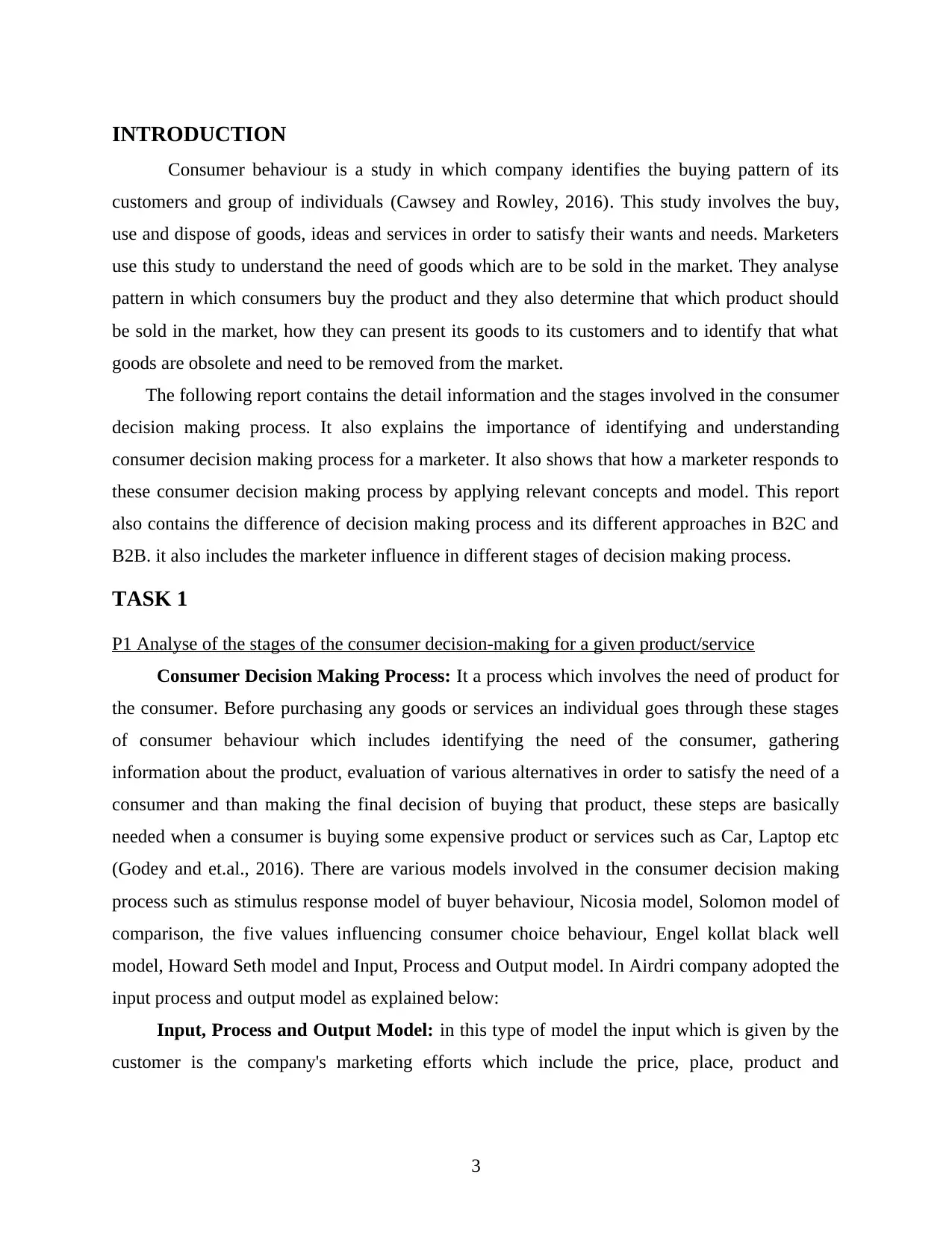
INTRODUCTION
Consumer behaviour is a study in which company identifies the buying pattern of its
customers and group of individuals (Cawsey and Rowley, 2016). This study involves the buy,
use and dispose of goods, ideas and services in order to satisfy their wants and needs. Marketers
use this study to understand the need of goods which are to be sold in the market. They analyse
pattern in which consumers buy the product and they also determine that which product should
be sold in the market, how they can present its goods to its customers and to identify that what
goods are obsolete and need to be removed from the market.
The following report contains the detail information and the stages involved in the consumer
decision making process. It also explains the importance of identifying and understanding
consumer decision making process for a marketer. It also shows that how a marketer responds to
these consumer decision making process by applying relevant concepts and model. This report
also contains the difference of decision making process and its different approaches in B2C and
B2B. it also includes the marketer influence in different stages of decision making process.
TASK 1
P1 Analyse of the stages of the consumer decision-making for a given product/service
Consumer Decision Making Process: It a process which involves the need of product for
the consumer. Before purchasing any goods or services an individual goes through these stages
of consumer behaviour which includes identifying the need of the consumer, gathering
information about the product, evaluation of various alternatives in order to satisfy the need of a
consumer and than making the final decision of buying that product, these steps are basically
needed when a consumer is buying some expensive product or services such as Car, Laptop etc
(Godey and et.al., 2016). There are various models involved in the consumer decision making
process such as stimulus response model of buyer behaviour, Nicosia model, Solomon model of
comparison, the five values influencing consumer choice behaviour, Engel kollat black well
model, Howard Seth model and Input, Process and Output model. In Airdri company adopted the
input process and output model as explained below:
Input, Process and Output Model: in this type of model the input which is given by the
customer is the company's marketing efforts which include the price, place, product and
3
Consumer behaviour is a study in which company identifies the buying pattern of its
customers and group of individuals (Cawsey and Rowley, 2016). This study involves the buy,
use and dispose of goods, ideas and services in order to satisfy their wants and needs. Marketers
use this study to understand the need of goods which are to be sold in the market. They analyse
pattern in which consumers buy the product and they also determine that which product should
be sold in the market, how they can present its goods to its customers and to identify that what
goods are obsolete and need to be removed from the market.
The following report contains the detail information and the stages involved in the consumer
decision making process. It also explains the importance of identifying and understanding
consumer decision making process for a marketer. It also shows that how a marketer responds to
these consumer decision making process by applying relevant concepts and model. This report
also contains the difference of decision making process and its different approaches in B2C and
B2B. it also includes the marketer influence in different stages of decision making process.
TASK 1
P1 Analyse of the stages of the consumer decision-making for a given product/service
Consumer Decision Making Process: It a process which involves the need of product for
the consumer. Before purchasing any goods or services an individual goes through these stages
of consumer behaviour which includes identifying the need of the consumer, gathering
information about the product, evaluation of various alternatives in order to satisfy the need of a
consumer and than making the final decision of buying that product, these steps are basically
needed when a consumer is buying some expensive product or services such as Car, Laptop etc
(Godey and et.al., 2016). There are various models involved in the consumer decision making
process such as stimulus response model of buyer behaviour, Nicosia model, Solomon model of
comparison, the five values influencing consumer choice behaviour, Engel kollat black well
model, Howard Seth model and Input, Process and Output model. In Airdri company adopted the
input process and output model as explained below:
Input, Process and Output Model: in this type of model the input which is given by the
customer is the company's marketing efforts which include the price, place, product and
3
⊘ This is a preview!⊘
Do you want full access?
Subscribe today to unlock all pages.

Trusted by 1+ million students worldwide

promotion and social environment which include the references group, family, society, etc. these
two factor collectively create the input in minds of customers.
Following are the five stages involved in the decision making process of the consumer:
Need Recognition: it basically occurs when a consumer identifies the need for a given
product and to fill up the gap of a particular product. It is important for companies to
determine the need of its customers and provide the specific good in order to fulfil their
need.
Information Search: This stage involves the complete research about the product. In this
stage consumer tries to gather information about the product from various different
sources. For the purpose of gathering information a consumer may involves its reference
group, internet, company brochures about the product. In this step consumer tries to find
out the consumers who are already using that product, they heavily relay on the reviews
about the product used by various consumers.
Evaluation of Alternatives: This step involves in the evaluation of various alternatives
which are available in the market in order to satisfy their need. After the determination of
the need and the product which can satisfy its need they switch to the various alternatives
available. In this process the consumer may evaluate the reviews, price, quality and
various other factors and then select a most preferred product which satisfies their
parameter.
Purchase Decision: After all the above stages are passed than the consumer makes a
final decision whether to purchase a product or to research more to satisfy their needs. In
this stage consumer has already evaluated all the possible reasons and facts and had
finally arrived at a decisions to purchase the product or service. This can be based upon
various reasons including the emotional connections of their family members or various
marketing campaigns or sometimes it may depend on both.
Post Purchase Behaviour: This is a stage in which consumer analyse that whether the
product is able to satisfy their needs or not (.Lantos, 2015). If the experience achieved
from the product is positive than it may help the company to increase its customer base
they will help in influencing other potential customers to buy that product and will
become brand ambassador of the product brand.
4
two factor collectively create the input in minds of customers.
Following are the five stages involved in the decision making process of the consumer:
Need Recognition: it basically occurs when a consumer identifies the need for a given
product and to fill up the gap of a particular product. It is important for companies to
determine the need of its customers and provide the specific good in order to fulfil their
need.
Information Search: This stage involves the complete research about the product. In this
stage consumer tries to gather information about the product from various different
sources. For the purpose of gathering information a consumer may involves its reference
group, internet, company brochures about the product. In this step consumer tries to find
out the consumers who are already using that product, they heavily relay on the reviews
about the product used by various consumers.
Evaluation of Alternatives: This step involves in the evaluation of various alternatives
which are available in the market in order to satisfy their need. After the determination of
the need and the product which can satisfy its need they switch to the various alternatives
available. In this process the consumer may evaluate the reviews, price, quality and
various other factors and then select a most preferred product which satisfies their
parameter.
Purchase Decision: After all the above stages are passed than the consumer makes a
final decision whether to purchase a product or to research more to satisfy their needs. In
this stage consumer has already evaluated all the possible reasons and facts and had
finally arrived at a decisions to purchase the product or service. This can be based upon
various reasons including the emotional connections of their family members or various
marketing campaigns or sometimes it may depend on both.
Post Purchase Behaviour: This is a stage in which consumer analyse that whether the
product is able to satisfy their needs or not (.Lantos, 2015). If the experience achieved
from the product is positive than it may help the company to increase its customer base
they will help in influencing other potential customers to buy that product and will
become brand ambassador of the product brand.
4
Paraphrase This Document
Need a fresh take? Get an instant paraphrase of this document with our AI Paraphraser
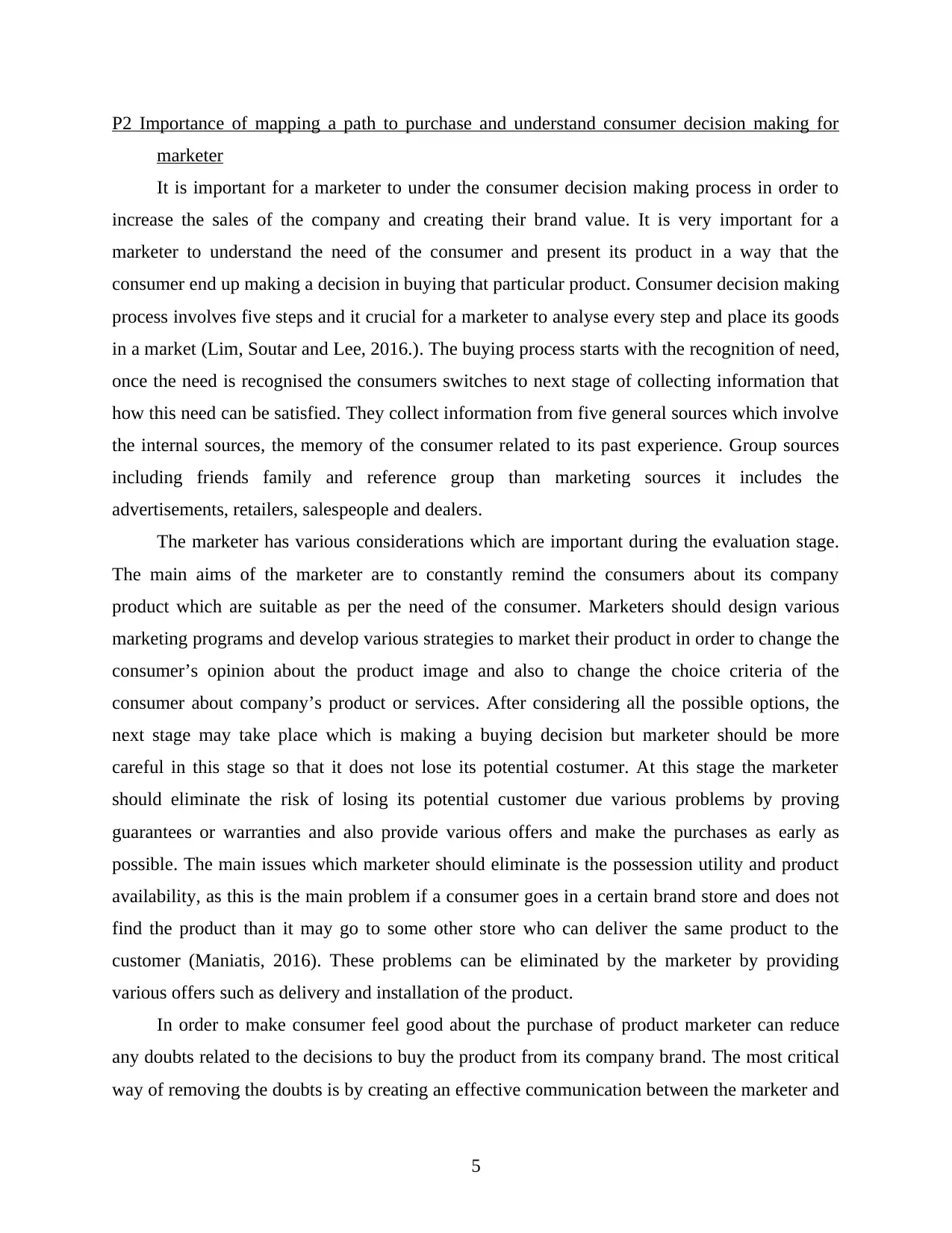
P2 Importance of mapping a path to purchase and understand consumer decision making for
marketer
It is important for a marketer to under the consumer decision making process in order to
increase the sales of the company and creating their brand value. It is very important for a
marketer to understand the need of the consumer and present its product in a way that the
consumer end up making a decision in buying that particular product. Consumer decision making
process involves five steps and it crucial for a marketer to analyse every step and place its goods
in a market (Lim, Soutar and Lee, 2016.). The buying process starts with the recognition of need,
once the need is recognised the consumers switches to next stage of collecting information that
how this need can be satisfied. They collect information from five general sources which involve
the internal sources, the memory of the consumer related to its past experience. Group sources
including friends family and reference group than marketing sources it includes the
advertisements, retailers, salespeople and dealers.
The marketer has various considerations which are important during the evaluation stage.
The main aims of the marketer are to constantly remind the consumers about its company
product which are suitable as per the need of the consumer. Marketers should design various
marketing programs and develop various strategies to market their product in order to change the
consumer’s opinion about the product image and also to change the choice criteria of the
consumer about company’s product or services. After considering all the possible options, the
next stage may take place which is making a buying decision but marketer should be more
careful in this stage so that it does not lose its potential costumer. At this stage the marketer
should eliminate the risk of losing its potential customer due various problems by proving
guarantees or warranties and also provide various offers and make the purchases as early as
possible. The main issues which marketer should eliminate is the possession utility and product
availability, as this is the main problem if a consumer goes in a certain brand store and does not
find the product than it may go to some other store who can deliver the same product to the
customer (Maniatis, 2016). These problems can be eliminated by the marketer by providing
various offers such as delivery and installation of the product.
In order to make consumer feel good about the purchase of product marketer can reduce
any doubts related to the decisions to buy the product from its company brand. The most critical
way of removing the doubts is by creating an effective communication between the marketer and
5
marketer
It is important for a marketer to under the consumer decision making process in order to
increase the sales of the company and creating their brand value. It is very important for a
marketer to understand the need of the consumer and present its product in a way that the
consumer end up making a decision in buying that particular product. Consumer decision making
process involves five steps and it crucial for a marketer to analyse every step and place its goods
in a market (Lim, Soutar and Lee, 2016.). The buying process starts with the recognition of need,
once the need is recognised the consumers switches to next stage of collecting information that
how this need can be satisfied. They collect information from five general sources which involve
the internal sources, the memory of the consumer related to its past experience. Group sources
including friends family and reference group than marketing sources it includes the
advertisements, retailers, salespeople and dealers.
The marketer has various considerations which are important during the evaluation stage.
The main aims of the marketer are to constantly remind the consumers about its company
product which are suitable as per the need of the consumer. Marketers should design various
marketing programs and develop various strategies to market their product in order to change the
consumer’s opinion about the product image and also to change the choice criteria of the
consumer about company’s product or services. After considering all the possible options, the
next stage may take place which is making a buying decision but marketer should be more
careful in this stage so that it does not lose its potential costumer. At this stage the marketer
should eliminate the risk of losing its potential customer due various problems by proving
guarantees or warranties and also provide various offers and make the purchases as early as
possible. The main issues which marketer should eliminate is the possession utility and product
availability, as this is the main problem if a consumer goes in a certain brand store and does not
find the product than it may go to some other store who can deliver the same product to the
customer (Maniatis, 2016). These problems can be eliminated by the marketer by providing
various offers such as delivery and installation of the product.
In order to make consumer feel good about the purchase of product marketer can reduce
any doubts related to the decisions to buy the product from its company brand. The most critical
way of removing the doubts is by creating an effective communication between the marketer and
5
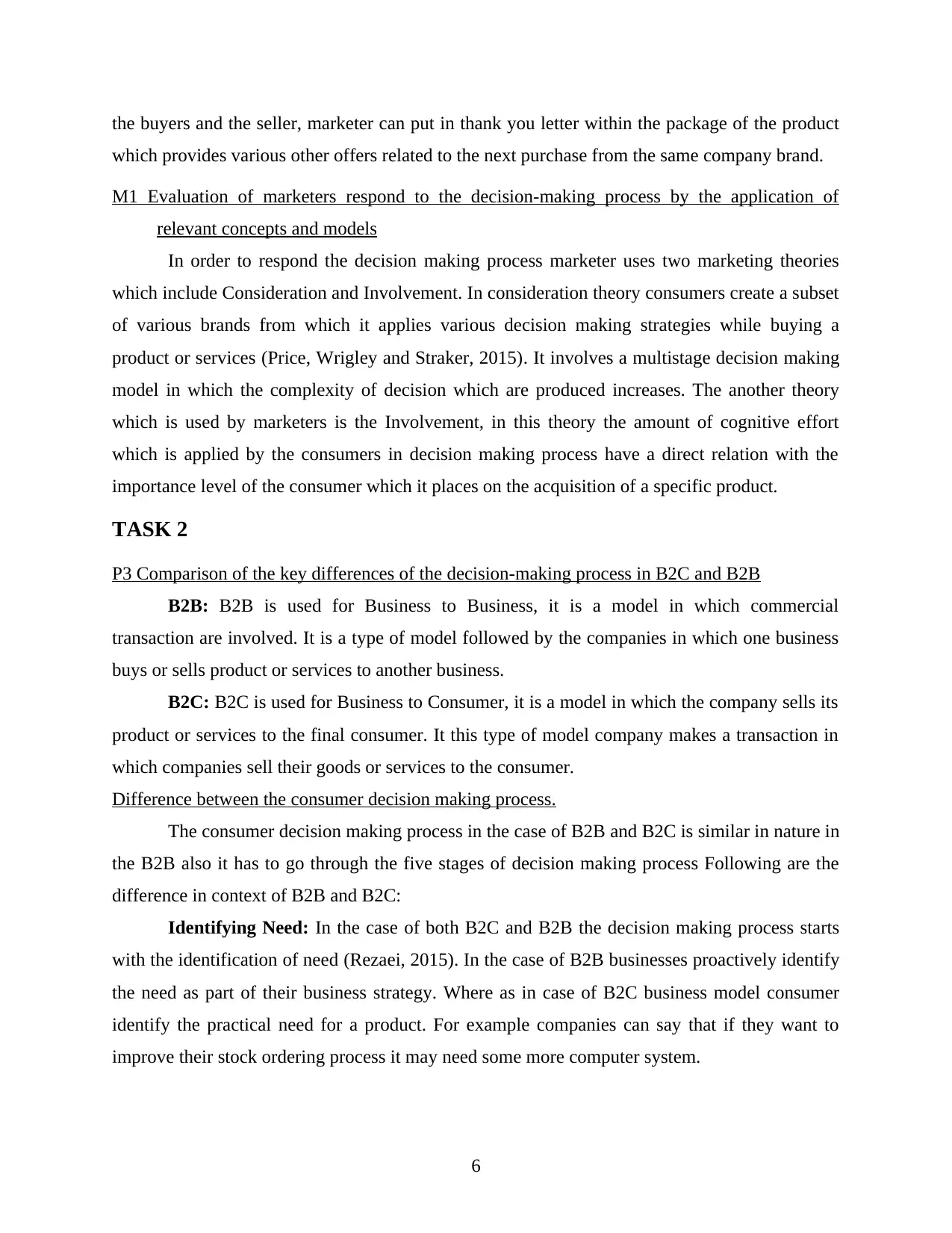
the buyers and the seller, marketer can put in thank you letter within the package of the product
which provides various other offers related to the next purchase from the same company brand.
M1 Evaluation of marketers respond to the decision-making process by the application of
relevant concepts and models
In order to respond the decision making process marketer uses two marketing theories
which include Consideration and Involvement. In consideration theory consumers create a subset
of various brands from which it applies various decision making strategies while buying a
product or services (Price, Wrigley and Straker, 2015). It involves a multistage decision making
model in which the complexity of decision which are produced increases. The another theory
which is used by marketers is the Involvement, in this theory the amount of cognitive effort
which is applied by the consumers in decision making process have a direct relation with the
importance level of the consumer which it places on the acquisition of a specific product.
TASK 2
P3 Comparison of the key differences of the decision-making process in B2C and B2B
B2B: B2B is used for Business to Business, it is a model in which commercial
transaction are involved. It is a type of model followed by the companies in which one business
buys or sells product or services to another business.
B2C: B2C is used for Business to Consumer, it is a model in which the company sells its
product or services to the final consumer. It this type of model company makes a transaction in
which companies sell their goods or services to the consumer.
Difference between the consumer decision making process.
The consumer decision making process in the case of B2B and B2C is similar in nature in
the B2B also it has to go through the five stages of decision making process Following are the
difference in context of B2B and B2C:
Identifying Need: In the case of both B2C and B2B the decision making process starts
with the identification of need (Rezaei, 2015). In the case of B2B businesses proactively identify
the need as part of their business strategy. Where as in case of B2C business model consumer
identify the practical need for a product. For example companies can say that if they want to
improve their stock ordering process it may need some more computer system.
6
which provides various other offers related to the next purchase from the same company brand.
M1 Evaluation of marketers respond to the decision-making process by the application of
relevant concepts and models
In order to respond the decision making process marketer uses two marketing theories
which include Consideration and Involvement. In consideration theory consumers create a subset
of various brands from which it applies various decision making strategies while buying a
product or services (Price, Wrigley and Straker, 2015). It involves a multistage decision making
model in which the complexity of decision which are produced increases. The another theory
which is used by marketers is the Involvement, in this theory the amount of cognitive effort
which is applied by the consumers in decision making process have a direct relation with the
importance level of the consumer which it places on the acquisition of a specific product.
TASK 2
P3 Comparison of the key differences of the decision-making process in B2C and B2B
B2B: B2B is used for Business to Business, it is a model in which commercial
transaction are involved. It is a type of model followed by the companies in which one business
buys or sells product or services to another business.
B2C: B2C is used for Business to Consumer, it is a model in which the company sells its
product or services to the final consumer. It this type of model company makes a transaction in
which companies sell their goods or services to the consumer.
Difference between the consumer decision making process.
The consumer decision making process in the case of B2B and B2C is similar in nature in
the B2B also it has to go through the five stages of decision making process Following are the
difference in context of B2B and B2C:
Identifying Need: In the case of both B2C and B2B the decision making process starts
with the identification of need (Rezaei, 2015). In the case of B2B businesses proactively identify
the need as part of their business strategy. Where as in case of B2C business model consumer
identify the practical need for a product. For example companies can say that if they want to
improve their stock ordering process it may need some more computer system.
6
⊘ This is a preview!⊘
Do you want full access?
Subscribe today to unlock all pages.

Trusted by 1+ million students worldwide
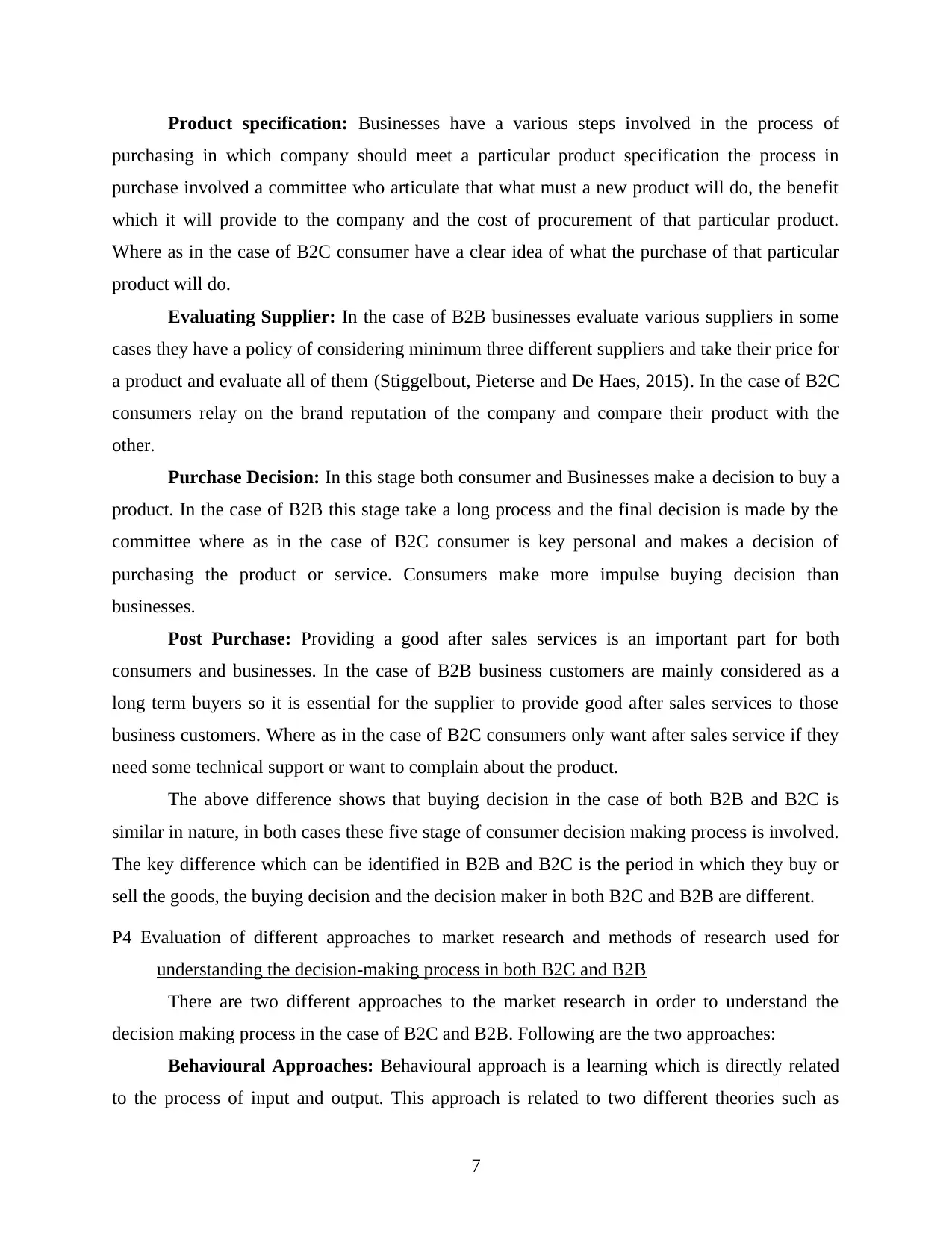
Product specification: Businesses have a various steps involved in the process of
purchasing in which company should meet a particular product specification the process in
purchase involved a committee who articulate that what must a new product will do, the benefit
which it will provide to the company and the cost of procurement of that particular product.
Where as in the case of B2C consumer have a clear idea of what the purchase of that particular
product will do.
Evaluating Supplier: In the case of B2B businesses evaluate various suppliers in some
cases they have a policy of considering minimum three different suppliers and take their price for
a product and evaluate all of them (Stiggelbout, Pieterse and De Haes, 2015). In the case of B2C
consumers relay on the brand reputation of the company and compare their product with the
other.
Purchase Decision: In this stage both consumer and Businesses make a decision to buy a
product. In the case of B2B this stage take a long process and the final decision is made by the
committee where as in the case of B2C consumer is key personal and makes a decision of
purchasing the product or service. Consumers make more impulse buying decision than
businesses.
Post Purchase: Providing a good after sales services is an important part for both
consumers and businesses. In the case of B2B business customers are mainly considered as a
long term buyers so it is essential for the supplier to provide good after sales services to those
business customers. Where as in the case of B2C consumers only want after sales service if they
need some technical support or want to complain about the product.
The above difference shows that buying decision in the case of both B2B and B2C is
similar in nature, in both cases these five stage of consumer decision making process is involved.
The key difference which can be identified in B2B and B2C is the period in which they buy or
sell the goods, the buying decision and the decision maker in both B2C and B2B are different.
P4 Evaluation of different approaches to market research and methods of research used for
understanding the decision-making process in both B2C and B2B
There are two different approaches to the market research in order to understand the
decision making process in the case of B2C and B2B. Following are the two approaches:
Behavioural Approaches: Behavioural approach is a learning which is directly related
to the process of input and output. This approach is related to two different theories such as
7
purchasing in which company should meet a particular product specification the process in
purchase involved a committee who articulate that what must a new product will do, the benefit
which it will provide to the company and the cost of procurement of that particular product.
Where as in the case of B2C consumer have a clear idea of what the purchase of that particular
product will do.
Evaluating Supplier: In the case of B2B businesses evaluate various suppliers in some
cases they have a policy of considering minimum three different suppliers and take their price for
a product and evaluate all of them (Stiggelbout, Pieterse and De Haes, 2015). In the case of B2C
consumers relay on the brand reputation of the company and compare their product with the
other.
Purchase Decision: In this stage both consumer and Businesses make a decision to buy a
product. In the case of B2B this stage take a long process and the final decision is made by the
committee where as in the case of B2C consumer is key personal and makes a decision of
purchasing the product or service. Consumers make more impulse buying decision than
businesses.
Post Purchase: Providing a good after sales services is an important part for both
consumers and businesses. In the case of B2B business customers are mainly considered as a
long term buyers so it is essential for the supplier to provide good after sales services to those
business customers. Where as in the case of B2C consumers only want after sales service if they
need some technical support or want to complain about the product.
The above difference shows that buying decision in the case of both B2B and B2C is
similar in nature, in both cases these five stage of consumer decision making process is involved.
The key difference which can be identified in B2B and B2C is the period in which they buy or
sell the goods, the buying decision and the decision maker in both B2C and B2B are different.
P4 Evaluation of different approaches to market research and methods of research used for
understanding the decision-making process in both B2C and B2B
There are two different approaches to the market research in order to understand the
decision making process in the case of B2C and B2B. Following are the two approaches:
Behavioural Approaches: Behavioural approach is a learning which is directly related
to the process of input and output. This approach is related to two different theories such as
7
Paraphrase This Document
Need a fresh take? Get an instant paraphrase of this document with our AI Paraphraser
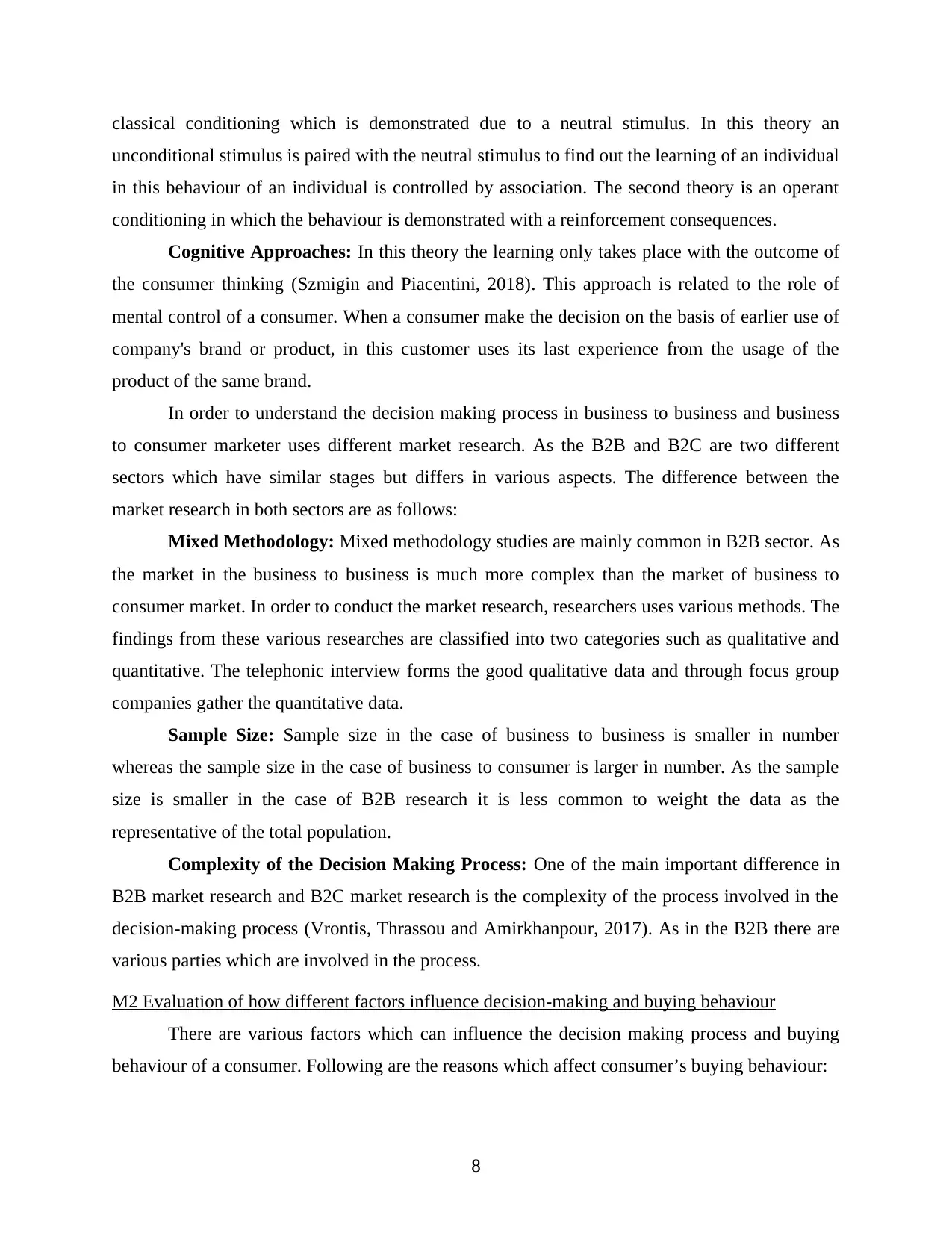
classical conditioning which is demonstrated due to a neutral stimulus. In this theory an
unconditional stimulus is paired with the neutral stimulus to find out the learning of an individual
in this behaviour of an individual is controlled by association. The second theory is an operant
conditioning in which the behaviour is demonstrated with a reinforcement consequences.
Cognitive Approaches: In this theory the learning only takes place with the outcome of
the consumer thinking (Szmigin and Piacentini, 2018). This approach is related to the role of
mental control of a consumer. When a consumer make the decision on the basis of earlier use of
company's brand or product, in this customer uses its last experience from the usage of the
product of the same brand.
In order to understand the decision making process in business to business and business
to consumer marketer uses different market research. As the B2B and B2C are two different
sectors which have similar stages but differs in various aspects. The difference between the
market research in both sectors are as follows:
Mixed Methodology: Mixed methodology studies are mainly common in B2B sector. As
the market in the business to business is much more complex than the market of business to
consumer market. In order to conduct the market research, researchers uses various methods. The
findings from these various researches are classified into two categories such as qualitative and
quantitative. The telephonic interview forms the good qualitative data and through focus group
companies gather the quantitative data.
Sample Size: Sample size in the case of business to business is smaller in number
whereas the sample size in the case of business to consumer is larger in number. As the sample
size is smaller in the case of B2B research it is less common to weight the data as the
representative of the total population.
Complexity of the Decision Making Process: One of the main important difference in
B2B market research and B2C market research is the complexity of the process involved in the
decision-making process (Vrontis, Thrassou and Amirkhanpour, 2017). As in the B2B there are
various parties which are involved in the process.
M2 Evaluation of how different factors influence decision-making and buying behaviour
There are various factors which can influence the decision making process and buying
behaviour of a consumer. Following are the reasons which affect consumer’s buying behaviour:
8
unconditional stimulus is paired with the neutral stimulus to find out the learning of an individual
in this behaviour of an individual is controlled by association. The second theory is an operant
conditioning in which the behaviour is demonstrated with a reinforcement consequences.
Cognitive Approaches: In this theory the learning only takes place with the outcome of
the consumer thinking (Szmigin and Piacentini, 2018). This approach is related to the role of
mental control of a consumer. When a consumer make the decision on the basis of earlier use of
company's brand or product, in this customer uses its last experience from the usage of the
product of the same brand.
In order to understand the decision making process in business to business and business
to consumer marketer uses different market research. As the B2B and B2C are two different
sectors which have similar stages but differs in various aspects. The difference between the
market research in both sectors are as follows:
Mixed Methodology: Mixed methodology studies are mainly common in B2B sector. As
the market in the business to business is much more complex than the market of business to
consumer market. In order to conduct the market research, researchers uses various methods. The
findings from these various researches are classified into two categories such as qualitative and
quantitative. The telephonic interview forms the good qualitative data and through focus group
companies gather the quantitative data.
Sample Size: Sample size in the case of business to business is smaller in number
whereas the sample size in the case of business to consumer is larger in number. As the sample
size is smaller in the case of B2B research it is less common to weight the data as the
representative of the total population.
Complexity of the Decision Making Process: One of the main important difference in
B2B market research and B2C market research is the complexity of the process involved in the
decision-making process (Vrontis, Thrassou and Amirkhanpour, 2017). As in the B2B there are
various parties which are involved in the process.
M2 Evaluation of how different factors influence decision-making and buying behaviour
There are various factors which can influence the decision making process and buying
behaviour of a consumer. Following are the reasons which affect consumer’s buying behaviour:
8
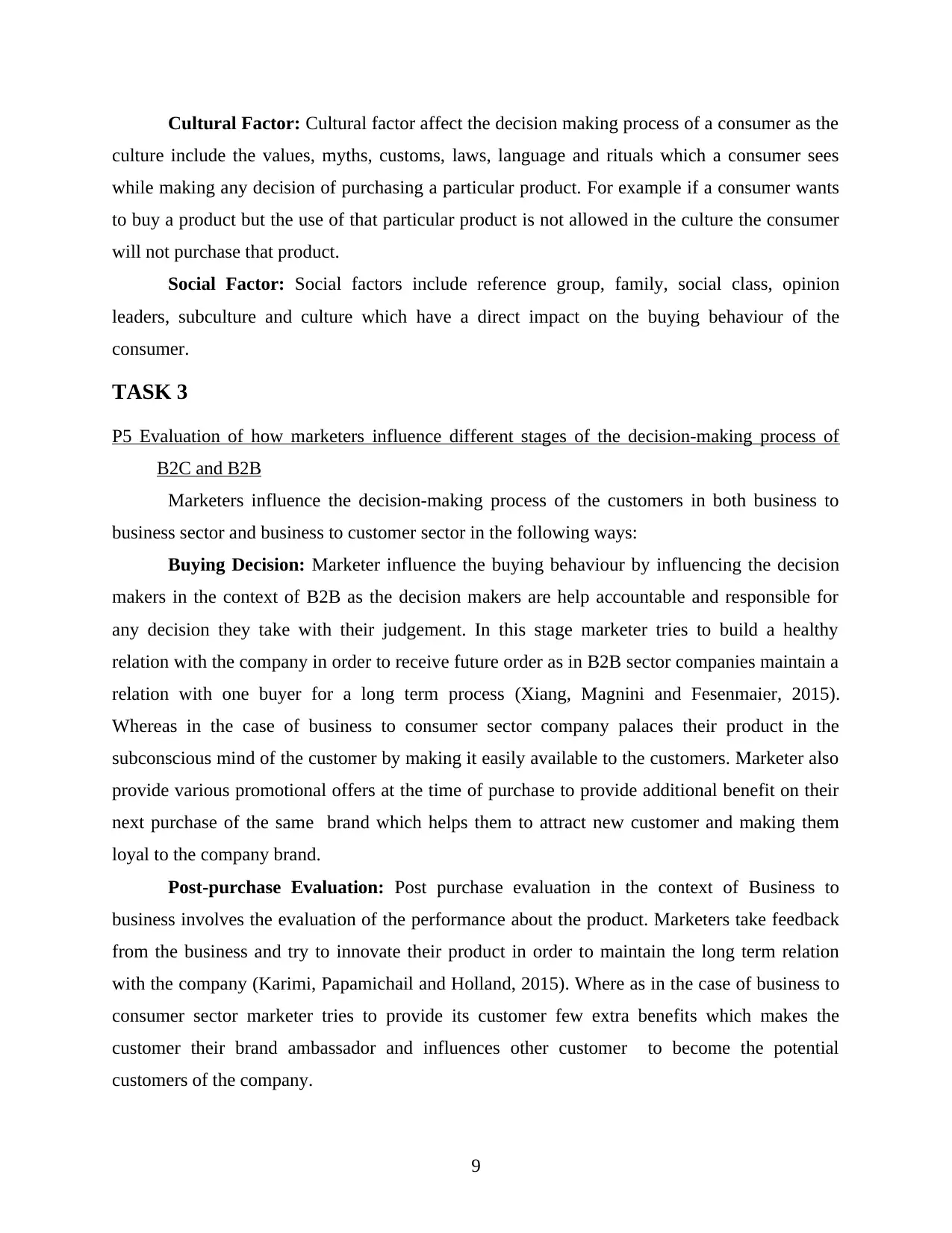
Cultural Factor: Cultural factor affect the decision making process of a consumer as the
culture include the values, myths, customs, laws, language and rituals which a consumer sees
while making any decision of purchasing a particular product. For example if a consumer wants
to buy a product but the use of that particular product is not allowed in the culture the consumer
will not purchase that product.
Social Factor: Social factors include reference group, family, social class, opinion
leaders, subculture and culture which have a direct impact on the buying behaviour of the
consumer.
TASK 3
P5 Evaluation of how marketers influence different stages of the decision-making process of
B2C and B2B
Marketers influence the decision-making process of the customers in both business to
business sector and business to customer sector in the following ways:
Buying Decision: Marketer influence the buying behaviour by influencing the decision
makers in the context of B2B as the decision makers are help accountable and responsible for
any decision they take with their judgement. In this stage marketer tries to build a healthy
relation with the company in order to receive future order as in B2B sector companies maintain a
relation with one buyer for a long term process (Xiang, Magnini and Fesenmaier, 2015).
Whereas in the case of business to consumer sector company palaces their product in the
subconscious mind of the customer by making it easily available to the customers. Marketer also
provide various promotional offers at the time of purchase to provide additional benefit on their
next purchase of the same brand which helps them to attract new customer and making them
loyal to the company brand.
Post-purchase Evaluation: Post purchase evaluation in the context of Business to
business involves the evaluation of the performance about the product. Marketers take feedback
from the business and try to innovate their product in order to maintain the long term relation
with the company (Karimi, Papamichail and Holland, 2015). Where as in the case of business to
consumer sector marketer tries to provide its customer few extra benefits which makes the
customer their brand ambassador and influences other customer to become the potential
customers of the company.
9
culture include the values, myths, customs, laws, language and rituals which a consumer sees
while making any decision of purchasing a particular product. For example if a consumer wants
to buy a product but the use of that particular product is not allowed in the culture the consumer
will not purchase that product.
Social Factor: Social factors include reference group, family, social class, opinion
leaders, subculture and culture which have a direct impact on the buying behaviour of the
consumer.
TASK 3
P5 Evaluation of how marketers influence different stages of the decision-making process of
B2C and B2B
Marketers influence the decision-making process of the customers in both business to
business sector and business to customer sector in the following ways:
Buying Decision: Marketer influence the buying behaviour by influencing the decision
makers in the context of B2B as the decision makers are help accountable and responsible for
any decision they take with their judgement. In this stage marketer tries to build a healthy
relation with the company in order to receive future order as in B2B sector companies maintain a
relation with one buyer for a long term process (Xiang, Magnini and Fesenmaier, 2015).
Whereas in the case of business to consumer sector company palaces their product in the
subconscious mind of the customer by making it easily available to the customers. Marketer also
provide various promotional offers at the time of purchase to provide additional benefit on their
next purchase of the same brand which helps them to attract new customer and making them
loyal to the company brand.
Post-purchase Evaluation: Post purchase evaluation in the context of Business to
business involves the evaluation of the performance about the product. Marketers take feedback
from the business and try to innovate their product in order to maintain the long term relation
with the company (Karimi, Papamichail and Holland, 2015). Where as in the case of business to
consumer sector marketer tries to provide its customer few extra benefits which makes the
customer their brand ambassador and influences other customer to become the potential
customers of the company.
9
⊘ This is a preview!⊘
Do you want full access?
Subscribe today to unlock all pages.

Trusted by 1+ million students worldwide
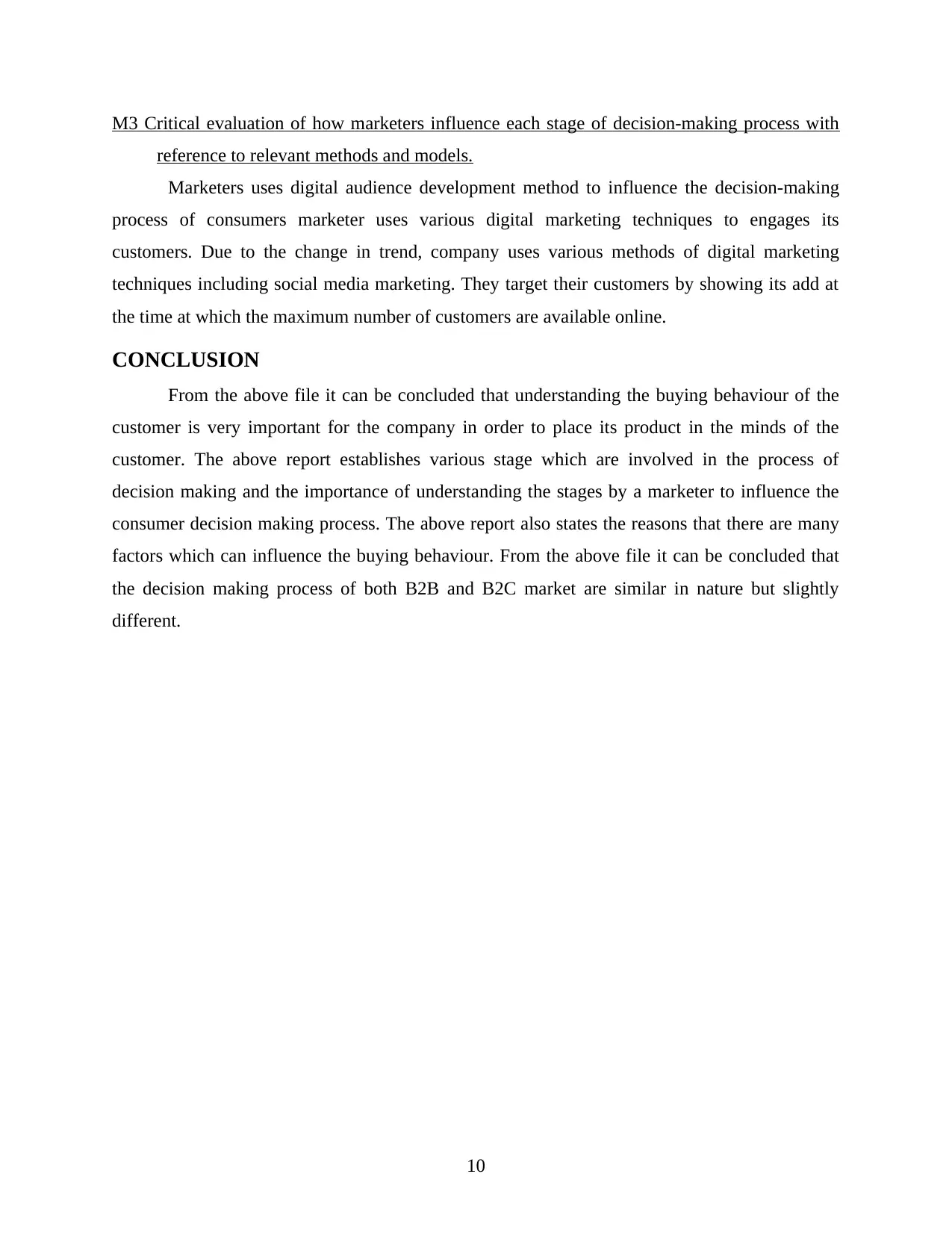
M3 Critical evaluation of how marketers influence each stage of decision-making process with
reference to relevant methods and models.
Marketers uses digital audience development method to influence the decision-making
process of consumers marketer uses various digital marketing techniques to engages its
customers. Due to the change in trend, company uses various methods of digital marketing
techniques including social media marketing. They target their customers by showing its add at
the time at which the maximum number of customers are available online.
CONCLUSION
From the above file it can be concluded that understanding the buying behaviour of the
customer is very important for the company in order to place its product in the minds of the
customer. The above report establishes various stage which are involved in the process of
decision making and the importance of understanding the stages by a marketer to influence the
consumer decision making process. The above report also states the reasons that there are many
factors which can influence the buying behaviour. From the above file it can be concluded that
the decision making process of both B2B and B2C market are similar in nature but slightly
different.
10
reference to relevant methods and models.
Marketers uses digital audience development method to influence the decision-making
process of consumers marketer uses various digital marketing techniques to engages its
customers. Due to the change in trend, company uses various methods of digital marketing
techniques including social media marketing. They target their customers by showing its add at
the time at which the maximum number of customers are available online.
CONCLUSION
From the above file it can be concluded that understanding the buying behaviour of the
customer is very important for the company in order to place its product in the minds of the
customer. The above report establishes various stage which are involved in the process of
decision making and the importance of understanding the stages by a marketer to influence the
consumer decision making process. The above report also states the reasons that there are many
factors which can influence the buying behaviour. From the above file it can be concluded that
the decision making process of both B2B and B2C market are similar in nature but slightly
different.
10
Paraphrase This Document
Need a fresh take? Get an instant paraphrase of this document with our AI Paraphraser

REFERENCES
Books and journals
Cawsey, T. and Rowley, J., 2016. Social media brand building strategies in B2B
companies. Marketing Intelligence & Planning. 34(6). pp.754-776.
Godey, B., and et.al., 2016. Social media marketing efforts of luxury brands: Influence on brand
equity and consumer behavior. Journal of business research. 69(12). pp.5833-5841.
Karimi, S., Papamichail, K. N. and Holland, C. P., 2015. The effect of prior knowledge and
decision-making style on the online purchase decision-making process: A typology of
consumer shopping behaviour. Decision Support Systems. 77. pp.137-147.
Lantos, G. P., 2015. Consumer behavior in action: Real-life applications for marketing
managers. Routledge.
Lim, K. L., Soutar, G. N. and Lee, J. A., 2016. Factors affecting investment intentions: A
consumer behaviour perspective. In Financial Literacy and the Limits of Financial
Decision-Making(pp. 201-223). Palgrave Macmillan, Cham.
Maniatis, P., 2016. Investigating factors influencing consumer decision-making while choosing
green products. Journal of Cleaner Production. 132. pp.215-228.
Price, R. A., Wrigley, C. and Straker, K., 2015. Not just what they want, but why they want it:
Traditional market research to deep customer insights. Qualitative Market Research: An
International Journal. 18(2). pp.230-248.
Rezaei, S., 2015. Segmenting consumer decision-making styles (CDMS) toward marketing
practice: A partial least squares (PLS) path modeling approach. Journal of Retailing and
Consumer Services. 22. pp.1-15.
Stiggelbout, A. M., Pieterse, A. H. and De Haes, J. C. J. M., 2015. Shared decision making:
concepts, evidence, and practice. Patient education and counseling. 98(10). pp.1172-
1179.
Szmigin, I. and Piacentini, M., 2018. Consumer behaviour. Oxford University Press.
Vrontis, D., Thrassou, A. and Amirkhanpour, M., 2017. B2C smart retailing: A consumer-
focused value-based analysis of interactions and synergies. Technological Forecasting
and Social Change. 124. pp.271-282.
Xiang, Z., Magnini, V. P. and Fesenmaier, D. R., 2015. Information technology and consumer
behavior in travel and tourism: Insights from travel planning using the internet. Journal
of Retailing and Consumer Services. 22. pp.244-249.
11
Books and journals
Cawsey, T. and Rowley, J., 2016. Social media brand building strategies in B2B
companies. Marketing Intelligence & Planning. 34(6). pp.754-776.
Godey, B., and et.al., 2016. Social media marketing efforts of luxury brands: Influence on brand
equity and consumer behavior. Journal of business research. 69(12). pp.5833-5841.
Karimi, S., Papamichail, K. N. and Holland, C. P., 2015. The effect of prior knowledge and
decision-making style on the online purchase decision-making process: A typology of
consumer shopping behaviour. Decision Support Systems. 77. pp.137-147.
Lantos, G. P., 2015. Consumer behavior in action: Real-life applications for marketing
managers. Routledge.
Lim, K. L., Soutar, G. N. and Lee, J. A., 2016. Factors affecting investment intentions: A
consumer behaviour perspective. In Financial Literacy and the Limits of Financial
Decision-Making(pp. 201-223). Palgrave Macmillan, Cham.
Maniatis, P., 2016. Investigating factors influencing consumer decision-making while choosing
green products. Journal of Cleaner Production. 132. pp.215-228.
Price, R. A., Wrigley, C. and Straker, K., 2015. Not just what they want, but why they want it:
Traditional market research to deep customer insights. Qualitative Market Research: An
International Journal. 18(2). pp.230-248.
Rezaei, S., 2015. Segmenting consumer decision-making styles (CDMS) toward marketing
practice: A partial least squares (PLS) path modeling approach. Journal of Retailing and
Consumer Services. 22. pp.1-15.
Stiggelbout, A. M., Pieterse, A. H. and De Haes, J. C. J. M., 2015. Shared decision making:
concepts, evidence, and practice. Patient education and counseling. 98(10). pp.1172-
1179.
Szmigin, I. and Piacentini, M., 2018. Consumer behaviour. Oxford University Press.
Vrontis, D., Thrassou, A. and Amirkhanpour, M., 2017. B2C smart retailing: A consumer-
focused value-based analysis of interactions and synergies. Technological Forecasting
and Social Change. 124. pp.271-282.
Xiang, Z., Magnini, V. P. and Fesenmaier, D. R., 2015. Information technology and consumer
behavior in travel and tourism: Insights from travel planning using the internet. Journal
of Retailing and Consumer Services. 22. pp.244-249.
11
1 out of 11
Related Documents
Your All-in-One AI-Powered Toolkit for Academic Success.
+13062052269
info@desklib.com
Available 24*7 on WhatsApp / Email
![[object Object]](/_next/static/media/star-bottom.7253800d.svg)
Unlock your academic potential
Copyright © 2020–2025 A2Z Services. All Rights Reserved. Developed and managed by ZUCOL.




